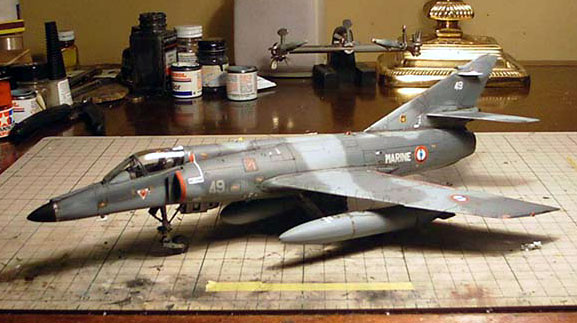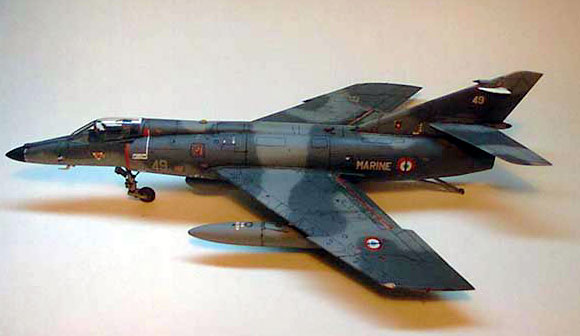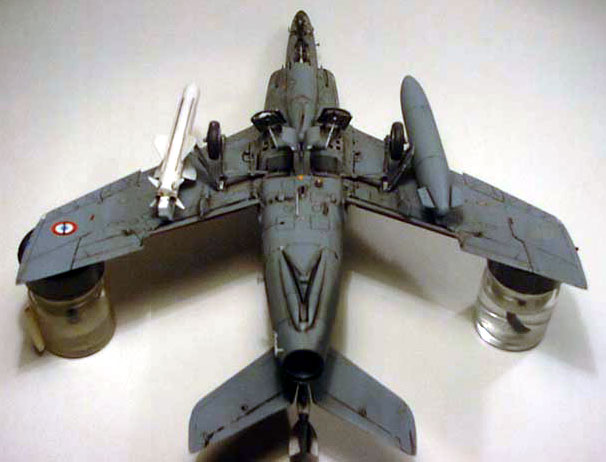|
Dassault-Breguet
Super Etendard
by Luis Felipe Herrera S.
|
 |
|
Dassault-Breguet
Super Etendard |

HyperScale is proudly supported by
Squadron.com
The Dassault-Breguet Super Etendard is a French single-seat land and
carrier-based attack and strike aircraft. It is armed with two 30 mm
DEFA 552A cannon in the underside of the forward fuselage (just below
the air intakes) and up to 2100 kg of disposable stores carried on five
hardpoints, one under the fuselage and two under each wing.
The Super Etendard was developed in the early 1970s on the basis of
the Etendard IVM. It was intended to replace Etendards IVP and F-8Es.
The Super Etendard first flew in October 1974 and in comparison with
its predecessor has much improved avionics (including search rather than
ranging radar), a more powerful SNECMA Atar 8K-50 turbofan engine and
considerably enhanced aerodynamics, replacing aircraft of the 11F, 14F
(disbanded in July 1991) and 17F Flotilles.

By the time the Falklands War began in 1982, Argentina had received
five Super Etendards. These made their operational debut when they sank
HMS Sheffield following the destruction of the ship Atlantic
Conveyor using the deadly AM-39 Exocet missile on both occasions.
Super-Etendards operate from the CV Foch, NAS Landivisiau and soon
from CVN Charles de Gaulle under the in the form of the 11F and 17F
squadrons. It was also also used by Iraq and they attacked many Iranian
tankers with their AM-39 Exocet. This aircraft has also taken part in
the Lebanese, Yugoslavian and Kosovo wars.
|
Heller's 1/48 Scale Super Entendard |
The kit is Hellerís 1/48 scale, kit 80420. It is moulded in light
gray plastic. This plastic is a little soft but cuts and sands pretty
well. It features nice recessed panel lines. The sprues have a tiny
amount of flash, they contain approximately 120 gray parts and 5 clear
ones.
 Decals
are for two versions. One is a French version camouflaged in two tones
of gray, and the other an Argentinian bird painted in dark gray over
white. The decals are typical Heller, lots of clear film residue and a
little bit out or register, one good thing is that it comes full of
stencilling. Decals
are for two versions. One is a French version camouflaged in two tones
of gray, and the other an Argentinian bird painted in dark gray over
white. The decals are typical Heller, lots of clear film residue and a
little bit out or register, one good thing is that it comes full of
stencilling.
The kit features the following options: One Exocet missile, a drop
tank and a buddy pack, you can build it with the flaps in the extended
or retracted position, wing tips folded / extended, arrestor hook, speed
brakes open or closed, canopy open/closed, refueling probe.
I wanted to build this aircraft straight from the box so I didnít go
into any modifications or extra detailing other than adding maskinf tape
seatbelts.
Construction starts with the nose wheel, which is a good
representation of the real one, then came the ejection seat this one is
a bit soft on details, the only addition I did to the aircraft was on
this particular item, I added masking tape seatbelts, then gave it a
wash with Pelikan drawing ink and then drybrushed with the base colors.
Next came all the external stores and the main landing gear, they
were built without problems I only used a very small ammount of putty in
the tip of the tanks.
Cockpit
This area does not have much detail The cockpit tub comes in just one
part then you add the control stick and front panel, they were assembled
as per instructions ans painted.The cockpit was weathered with Sepia
Pelikan drawing ink, then drybrushed with black and a dark gray to
highlight corners and then sprayed with matt varnish to kill the gloss
of the ink.
Fuselage and Wings
The fuselage comes in two parts that sandwiches the lower part of the
wing, cockpit and burner can. Theres a bit of a problem here, after test
fitting I concluded that the inner plates of the intakes required a bit
of trimming so they could fit in. The front part of the fuselage (where
the two halves meet around the cockpit and the engine intake area)
needed a lot of sanding (probably because of the lead weights I placed
inside)and rescribing the lost details.

Wing to fuselage fit is very good, the only place which requieres
attention are the wing tips and the flaps.
Another problem I came up with was that the ejection seat was too tall
to place the canopy closed so it needed a bit of trimming in the lower
part of the seat. Then I noticed that the canopy was a bit short and
that placing it in the closed position would leave a gap about 2 or 3mm,
so what I did was thatI filled this gap with various applications of
white glue.
I chose to build the French version as I intended to enter this kit
in a local show which was sponsored by the French Embassy.
Anyway, the model was painted using Model Master and Humbrol enamels
after preshading of the panel lines, they were airbrushed freehand
through a Paasche VL airbrush. The radar cone was masked and painted
matt black and the ring where it meets the fuselage silver. Then the
model was covered with a coat of Testorís Glosscote as a base for the
decals. Decals were applied next, they had to be trimmed to get rid of
the excess clear film, they were applied using the Aeromasterís system (Aeroset/sol).
After they all snuggled down the panel lines the model received
another coat of Testors Glosscote.
The model was weathered with drawing ink to accent the panel lines
and to make the very subtle staining of the airframe, the technique I
use goes like this: After decaling and a coat of clear gloss I start
filling each of the panel lines with sepia drawing ink straight from the
bottle, wait until its dry, then take a wet cotton swab or an old t
shirt and wipe the aircraft in the direction of the airflow, this
process stains the entire airframe while accenting panel lines.
Landing gear was attached, also the external stores, the main wheel
covers were sanded to thin the because they are extremely thick. The
speed brakes were attached in the open position and the tail hook down.
This kit is not the aircraft you see every day at contest tables or
online galleries, so it was quite a change from building WWII Luftwaffe
airplanes. Besides the fit problems and getting accustomed to the type
of plastic, I recommend this kit to the intermediate-advanced modeler,
with a set of new decals and some cockpit enhancements the kit can be
turned into a really good one!. I really enjoyed building it and look
forward into building another.
The kit took a 2nd place in the OOB 1/48 scale jets category and took
a recognition from the French Embassy in Caracas, Venezuela.
-
Various pictures on the web.
-
French Fleet Air Arm -
http://frenchnavy.free.fr/
-
World Air Power Journal Ė Encyclopedia of
World Military Aircraft (Airtime Publishing)
Text, Images and Model Copyright © 2002 by
Luis Felipe Herrera S.
Page Created 19 March, 2002
Last Updated
04 June, 2007
Back to HyperScale Main Page
Back to Features Index |
Home
| What's New |
Features |
Gallery |
Reviews |
Reference |
Forum |
Search